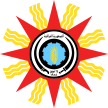
Back قومية عراقية Arabic Nacionalisme iraquià Catalan ناسیۆنالیزمی عێراقی CKB Nacionalismo iraquí Spanish Nationalisme irakien French Nacionalismo iraquí Galician イラクのナショナリズム Japanese
Iraqi nationalism is a form of nationalism that asserts the belief that Iraqis form a nation and promotes the cultural unity of Iraqis of different ethnoreligious groups such as Mesopotamian Arabs, Kurds, Turkmens, Assyrians (including Chaldeans and Syriacs), Yazidis, Mandeans, Shabaks and Yarsans.
Iraqi nationalism involves the recognition of an Iraqi identity stemming from ancient Mesopotamia including its civilizations and empires of Sumer, Akkad, Babylon and Assyria[1] and influenced Iraq's movement for independence from Ottoman and from British occupation and was an important factor in the 1920 Revolution against the British and the 1958 Revolution against the British-installed Hashemite monarchy.[2]
There are two prominent variants. One variant views an Iraqi nation as one that involves Arab, Turkmen, Assyrian and Kurdish people, all of whom have a common Mesopotamian heritage. It was promoted by Abd al-Karim Qasim, who was of mixed Arab-Kurdish, Sunni-Shia parentage.[3] A second variant is a dual nationalism and combines Iraqi nationalism and Arab nationalism, a much broader form of ethnic nationalism that supports Iraqi nationalism and links it to matters that impact Arabs as a whole.[4]: 174 Saddam Hussein believed that the recognition of the ancient Mesopotamian origins and heritage of Iraqi Arabs was complementary to supporting Arab nationalism.[4]: 174
The Ba'athist regime officially included the historic Kurdish Muslim leader Saladin as a patriotic symbol in Iraq. Saddam called himself son of the Babylonian King Nebuchadnezzar and had stamped the bricks of ancient Babylon with his name and titles next to him.[5][6]
- ^ Reich, Bernard. Political leaders of the contemporary Middle East and North Africa: A Bibliographical Dictionary. Westport, Connecticut, USA: Greenwood Press, Ltd, 1990. Pp. 245.
- ^ Bengio, Ofra. Saddam's Word: Political Discourse in Iraq. New York, New York, USA: Oxford University Press, 1998. Pp. 117-118.
- ^ By Kerim Yildiz, Georgina Fryer, Kurdish Human Rights Project. The Kurds: culture and language rights. Kurdish Human Rights Project, 2004. Pp. 58
- ^ a b Bashkin, Orit (2009). The other Iraq: pluralism and culture in Hashemite Iraq. Stanford, California, USA: Stanford University Press. ISBN 9780804774154.
- ^ Kiernan, Ben. Blood and Soil: A World History of Genocide and Extermination from Sparta to Darfur. Yale University Press, 2007. Pp. 587.
- ^ Magid, Pesha (2019-12-02). "Inside the Abandoned Babylon That Saddam Hussein Built". Atlas Obscura. Retrieved 2022-04-05.

